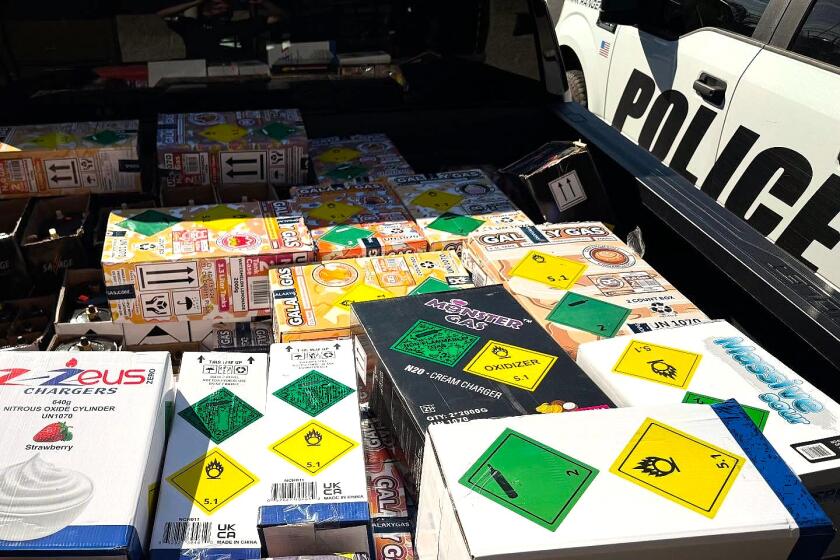Comments & Curiosities:
- Share via
Is your lawn famous? Mine isn’t. It’s just a common, everyday, garden-variety lawn.
Kevin Doane’s lawn, on the other hand, is very famous. It’s also dead, which is the problem, or not, depending on your point of view.
Kevin’s lawn, which is really a non-lawn, is the most famous brown patch in Costa Mesa. As you may recall, Doane is a Costa Mesa contractor who lost his job in 2008 when the economy went missing, gonzo, bub-bye, we’ll be in touch.
In an effort to save a few bucks and save the planet at the same time, Kevin decided to take the oft-heard advice about conserving water and using drought-resistant plants to heart.
If drought-resistant plants are the ticket, what plant could be more drought-resistant than a dead plant? It was perfect: no money, no plants, no problem. Sure enough, not long after Doane stopped watering his front lawn, it looked absolutely, well, dead.
Kevin Doane looked out on his new non-lawn and it was good. It was the perfect lawn for a new age, so brown it was green.
The city of Costa Mesa, however, had a slightly different opinion.
There are certain landscape standards in the municipal code about green things versus brown things versus dead things, they explained, and Doane’s non-lawn — even though it was resisting drought very well — did not meet those standards.
Doane was given 60 days to get something growing, but 60 days came and went and the lawn was still dead, fully and completely as in, not living, deceased, and really, really brown.
Not long after that, Doane was in possession of a violation notice from the city that carried a $150 fine, which he refused to pay and which eventually grew to $400 in fines, which is a lot of fines when you’re a contractor who is not doing any contracting.
After a number of visits to Costa Mesa City Council meetings during which he used his allotted three minutes to voice protests filled with passion, defiance and some pretty funny lines, Doane and his drought-resistant-but-dead lawn became what Italians call a cause célèbre.
Then, bam, Kevin and his missing lawn weren’t exactly Octo-mom, but they were close. Reporters and news crews from far and wide beat a path to his front door and it’s not like they had to be careful where they walked.
“I’ve lived my life in anonymity,“ Doane said at the time. “You wouldn’t believe how funny this has gotten.”
Now, some eight months later, it is done. The war is over, the truce is holding, and Doane got his 400 clams back from the city in return for doing some planting in his front yard. Calling it a lawn would be a stretch, but there are a few plants to be seen and the city planted some trees in the parkway.
There are still nagging questions though. Is it really green to be brown? And can you be brown and dead and green? As always, I have no idea. But here is what I want to know: Who started this lawn business anyway?
When you think about it, it is a little odd. We plant some seed or sod on a patch of dirt in front of our house, water it, trim it, feed it, weed it, but the one thing we almost never do is use it. In fact, if anyone steps on it, we worry.
Actually, what we think of as lawns started in England in the early 1600s, but they were not for the little people. English estates were adorned front and back with lush, green, close-cut lawns that set the manor house off from the surrounding fields.
The trimming part is what made having a lawn a coveted status symbol. Having a lawn meant you either had a small army of workers armed with scythes or a small army of sheep or other beasties armed with teeth, either munching or whacking away for hours at a time.
But then, in 1830, a funny thing happened. I’m sure more than one funny thing happened in 1830, but the one I’m talking about is that a gardening contraption was invented that was simple, ingenious and had very sharp blades that rotated quickly and cut grass evenly as you pushed the thing along by its long handle. It was called a “mowing machine” — soon shortened to “lawn mower.”
Again, bam. All of a sudden, almost anyone could have a lawn of their very own, just like Lord Broadbutt. Not as big maybe and not as perfect, but a lawn nonetheless, a lawn that said we are stylin’ for all the neighbors to see.
One hundred and eighty years later, people still love their lawns.
A NASA study used satellite images to determine that lawn grass is the largest irrigated crop in the U.S. — covering about 32 million acres of the country.
More than 50% of the water delivered to U.S. residences is used to water the lawn, except at Kevin Doane’s house. That leads us to the other battle royale about lawns, which Kevin found himself in the middle of, i.e., are irrigated green lawns really green?
“You betcha,” say the lawn people, most of whom have never even met Sarah Palin. Lawns, like trees, are the front line in the battle against global warming, they say. They cool the surface of the Earth, clean the air and control erosion.
“Don’t make us laugh,” say the anti-lawn people.
Lawns are a wasteful extravagance. They gobble water that could be much better used elsewhere, plus all that nasty pesticide and fertilizer finds its way into the ocean, rivers and lakes, and the thousand million gas-powered lawnmowers out there are an air polluting nightmare. Will the argument ever be settled? I have no idea.
But if Kevin Doane and the city can lay down their weapons and back away, there is always hope. Grass is a personal thing and I say let everyone do with it as they please. As far as I’m concerned, what happens in the front yard stays in the front yard. Hopefully.
I gotta go.
PETER BUFFA is a former Costa Mesa mayor. His column runs Sundays. He may be reached at [email protected].
All the latest on Orange County from Orange County.
Get our free TimesOC newsletter.
You may occasionally receive promotional content from the Daily Pilot.



